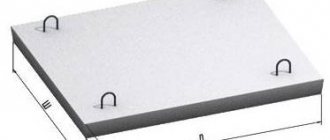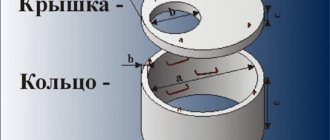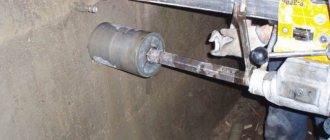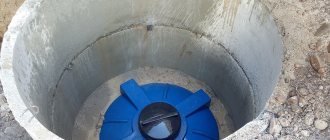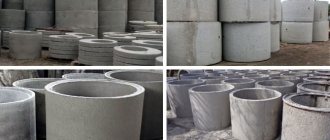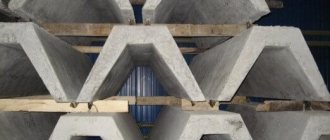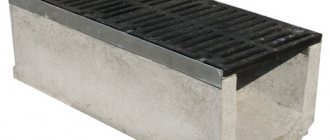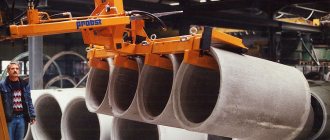There is so much information that rain and melt water that accumulates on surfaces brings a lot of trouble to both the material and the person. To prevent it from having a detrimental effect on the owl, it must be taken to a specially designated place - a storm drain. It is permissible to discharge water beyond the sidewalk. To bring everything to life, a whole drainage system is used. It is through it that water moves to the right place. There is a drain to drain water from the roof, and there is a system to drain water from the sidewalk. Its main element is a gutter in the form of an oblong container with a square, round or rectangular cross-section. The materials from which they are made are also very different. One of them is concrete.
It is concrete gutters that will be discussed in this article.
What is a concrete drain made of?
To make concrete gutters, different types of fiber-reinforced concrete are used. Finely processed polypropylene fibers are added to the finished mixture, thanks to which the gutters have low shrinkage deformation. In addition, fibers increase the bending resistance of concrete products. Metal fiber is often added to the mixture. Quite often you can find reinforced concrete drainage. It is made on the basis of cement, the grade of which is no less than M500. This design is much stronger than bending and holds its shape.
All concrete gutters, and even those that have a vertical drain, come complete with a grate. A concrete drain with a grate will be protected from branches, pieces of paper, leaves and other debris from the street. The material for gratings can be very different. Its choice depends on the location of the drain and the load on it. Fastening the gratings to concrete is possible thanks to special screws.
Note! These grilles can be removed without any problems to clean the channels as needed.
Self-installation
The installation of a storm drainage system requires compliance with certain rules. Initially, it is necessary to develop a project and make all measurements. The selection of products must be made taking into account the properties of the soil and the design load. It is also important to determine the maximum capacity and depth of location.
Preparing the trench
At this stage of work, it is necessary to take into account not only the size of the gutters, but also the possibility of installing a concrete layer at the bottom of the trench and side concrete supports.
The installation of channels should be done with a slope, in this way self-drainage of water is ensured. The length of the trench should be the entire length of the installation, and the width of the channels should exceed the width of the tray by 20 cm.
The depth should be greater than the dimensions of the gutters, taking into account the concrete layer, so that upon completion of installation of the drainage system, the gratings for storm channels are located 0.5 cm below the level of the surface into which installation is being carried out. To make work easier, you can use cords to mark the location of the trenches.
Upon completion of digging the canals, their bottom is covered with sand, which is compacted. A 10 cm layer of concrete mortar is poured on top of the sand, on top of which trays are laid.
In heaving soils, it is advisable to strengthen the structure with steel rods or wire.
Laying trays
The process of laying gutters consists of several stages:
- To facilitate installation work , gutters should be positioned along the entire channel.
- It is best to start laying products
- Gutters should be installed on a concrete pad that has not yet hardened. This cushion prevents the trays from moving when exposed to loads.
- When laying bends , it is necessary to monitor the level of inclination.
- After installing the first 2 trays , the junction between them is sealed using a soft polymer cord.
- After sealing with a rope , the seam is filled with concrete mixture.
- Water intakes are installed in the center of the trench, and to facilitate the removal of concrete residues, after installation is completed, they are covered with plastic film.
- between the sides of the trench and the trays.
- Corner joints are treated with sealant.
- If asphalt is laid over the drainage system, the trenches are covered with fiberboards.
Upon completion of the installation of the trays, the side spaces are filled with sand mixed with gravel. This mixture is compacted well.
If it is not possible to fill it with sand and gravel, the space is filled with concrete mortar. After the solution has hardened, the upper parts of the rainwater inlet are covered with metal gratings.
If necessary, to create corner joints, the gratings are sawed using a saw and a diamond-coated disk.
Places of application of concrete drainage
Concrete models are most often used for hard surfaces where moisture needs to be removed. After all, a drainage system is used for the soil. Where exactly are concrete gutters used?
- On the street and footpath, which are covered with either asphalt or paving slabs.
- On an open concrete area (airfield area, military facilities, ports).
- In the car park.
- At a gas station.
- In a large city square.
- On the territory of workshops, warehouses and other enterprises.
- Near infrastructure facilities.
They perform an important role - they maintain the integrity of the coating, increase its wear resistance and extend the service life of the material. In addition, the sidewalk or parking lot dries out faster after rain, which brings comfort to pedestrians.
Note! If you want to make a concrete drainage system next to your house, then don’t even think about it, it will all be in vain. The fact is that a simply dug ditch will not support the weight of a concrete tray. The soil tends to heave, especially in winter. As a result, the gutters will shift, their direction will change, and the structure will lose its appearance.
Concrete trays, what are they?
According to the method of manufacturing products, they can be divided into two types:
- Made by vibration casting.
- Made according to the principle of vibrocompression.
In the first case, the material is compacted and air is expelled from it due to the vibration created by the work table and the casting mold. Thus, the density of the material increases, and with it the strength.
As for the second method, the concrete is compacted using a powerful press. It is so powerful that all air bubbles come out under pressure. This is why cracks do not form in the material. The density is the highest, and so is the quality.
Note! If we talk about the device, they can be divided into regular channels and those that have a vertical water drain.
Types of trays used
A concrete tray can be different in shape, configuration, appearance, strength, purpose and other parameters. According to the method of installation, trays can be telescopic (elements are installed one inside the other, draining water from embankments, bridges along a slope) and edge trays (usually installed in a cascade or along roads at a single level).
Types of trays by section shape:
- Trapezoidal - assume telescopic installation, made in a trapezoid format.
- U-shaped - designed to drain minor volumes of water, an ideal choice for a private household.
- U-shaped - have the largest cross-sectional area and are used for installing systems with heavy loads.
Based on the material used, gutters can be made of concrete, with the addition of polymers and a sand mixture.
Concrete
The strongest and most durable products can withstand external loads ranging from 60 to 90 tons. They are made from cement and fillers, can be reinforced, come in different colors (if pigment is added to the concrete), and come in a huge variety of shapes and sizes.
Polymer concrete
They simultaneously have the properties of plastic and concrete waste. They are made from granite chips and quartz sand with special epoxy and polyester resins. Cement is replaced by polymer compounds, which makes the structure resistant to various types of chemical elements.
Due to the inclusion of plastic, the product is light in weight, which makes installation and creation of the entire system easier. Often such drains are used in private housing construction, equipped with gratings.
Polymer sand
Such gutters are the most modern and technologically advanced solution. The effluents have high plasticity rates and an extremely long service life. They are made from polymer chips with special sand of a very fine fraction.
Concrete drain guards
We mentioned gutter guards a little bit. So, the kit with a drain may include three types of gratings:
- made of cast iron (can be with a galvanized surface);
- made of stainless steel, which can be galvanized;
- made of durable plastic.
In the photo you can see a cast iron grate for a reinforced concrete gutter.
Note! Based on their design, gratings are divided into cellular or slotted.
The greater the load on the surface, the stronger the grate you need to use. For example, for parking or refueling, you need to use a grate made of cast iron or steel. And for a pedestrian area, a plastic gutter grid is sufficient.
Dimensions of concrete gutters
The standard size of one gutter is 1 m. But, as in any case, the length can be longer. It all depends on the mass and width of the gutter. As for the width, it may vary for different purposes. The minimum size is 14 cm, the maximum is 4 m. If we talk about the height of the products, then the minimum is 6 cm, the maximum is 1.68 m.
An important point is the volume of the tray. Most often you can find three types:
- L-1-7 and L-2-7, the capacity of which is 0.07 cubic meters.
- L-3-8, with a capacity of 0.14 cubic meters.
- L-300, which hold 0.3 cubic meters.
Reviews from our clients
Ivan Ivanov
I bought a storage tank and installed it myself with the help of a neighbor in the country.
Now everything I have is modern and stylish. I have established waste removal on a regular basis and am very satisfied. SEPTIC Service
2020-06-18T14:20:49+00:00
I bought a storage tank and installed it myself with the help of a neighbor in the country. Now everything I have is modern and stylish. I have established waste removal on a regular basis and am very satisfied.
https://bioseptik.ru/testimonials/ivan-ivanov/
Igor Chekalin
This company advised, selected and installed a septic tank for high groundwater.
Everything was done efficiently and on time. I think I have the right to recommend this company to you. SEPTIC Service
2020-06-18T14:21:10+00:00
This company advised, selected and installed a septic tank for high groundwater. Everything was done efficiently and on time. I think I have the right to recommend this company to you.
https://bioseptik.ru/testimonials/igor-chekalin/
Evgeny Serdyukov
I am very pleased with the turnkey installation of Favorite 2P.
I carried out the pumping once. I’ve been using it for 4 years now, and overall, I recommend it! SEPTIC Service
2020-06-18T14:21:28+00:00
I am very pleased with the turnkey installation of Favorite 2P. I carried out the pumping once. I’ve been using it for 4 years now, and overall, I recommend it!
https://bioseptik.ru/testimonials/evgenij-serdyukov/
Vladimir Serovsky
We bet Favorite 2P with a neighbor for two.
There were no complaints or claims regarding the work of the Septic Service company specialists. We are satisfied with both the work of the septic tank and its maintenance. SEPTIC Service
2020-06-18T14:21:41+00:00
We bet Favorite 2P with a neighbor for two. There were no complaints or claims regarding the work of the Septic Service company specialists. We are satisfied with both the work of the septic tank and its maintenance.
https://bioseptik.ru/testimonials/vladimir-serovskij/
Stanislav Belik
We installed FAVORITE 2P; there used to be a plastic septic tank (which became deformed after the winter).
We are completely satisfied with the new septic tank. We hope for its longevity. SEPTIC Service
2020-06-18T14:21:58+00:00
We installed FAVORITE 2P; there used to be a plastic septic tank (which became deformed after the winter). We are completely satisfied with the new septic tank. We hope for its longevity.
https://bioseptik.ru/testimonials/stanislav-belik/
Nikolay Perevedtsev
I was often bothered by a problem with the sewer system at my dacha, so I decided to contact them to install a storage tank, now the problem is solved, everything was done efficiently and quickly.
SEPTIC Service
2020-06-18T14:22:14+00:00
I was often bothered by a problem with the sewer system at my dacha, so I decided to contact them to install a storage tank, now the problem is solved, everything was done efficiently and quickly.
https://bioseptik.ru/testimonials/nikolaj-perevedntsev/
0
0
SEPTIC Service
Maximum load on gutter
What weight should concrete gutters be able to withstand? There are international standards that products must comply with. Each product has its own class:
- A15 - able to withstand a weight of 1.5 tons.
- B125 - able to withstand a weight of 12.5 tons.
- C250 – able to withstand a weight of 25 tons.
- D400 – able to withstand a weight of 40 tons.
- E600 - can withstand a weight of 60 tons.
- F900 – able to withstand a weight of 90 tons.
Advantages of concrete gutters
Having considered the characteristics, types and features of the material, you can find out its advantages over others. Let's look at 7 components that make a material a good option for installing a drain.
- Concrete does not rot or corrode. Due to this, the service life of concrete products is very long. A drain can last well for decades. And since the product itself is highly compacted during manufacturing, it is impossible to destroy it.
- Concrete has good frost resistance. The material easily tolerates temperature fluctuations without changing its structure. This is why concrete gutters can be used anywhere, in any conditions. Climate doesn't matter.
- Due to additional reinforcement with reinforcement rods or polypropylene fibers, the material is difficult to destroy and retains its shape well.
- The mass of reinforced concrete gutters is quite large. Due to this, they will not budge. This will be very difficult to do, even if the precipitation is very heavy.
- Concrete is an environmentally friendly material. It contains only natural ingredients. Therefore, it does not harm the health of others, animals and birds.
- Concrete gutters have a simple design and are effective at draining water from the surface. They are practical and easy to care for. You just need to clean the grates and trays of debris from time to time.
- High price-quality ratio. If we take into account the operational characteristics of a concrete drain, it completely pays for itself in a short time.
Installation of storm (rain) drainage trays
Storm (rain) plastic drainage system
Storm drainage trays are structures designed to collect and drain groundwater, melt and rainwater. We are talking about a system of gutters aimed at transporting water from any area to the sewer. Moreover, the installation of such products requires a minimum of excavation and installation operations. They are installed in areas where there is a limited depth.
Types of storm drainage trays
Today, the above drainage systems are conventionally divided into:
- plastic;
- metal;
- reinforced concrete;
- composite;
Plastic:
plastic drainage trays
The first option is the most common, due to its cost. Plastic trays are the most affordable and are easy to install due to their light weight. The advantages also include good resistance to the harmful effects of environmental factors. However, they have much less strength than their concrete counterparts. Such products deform faster and can move from place. Often, plastic trays are destroyed during leashes or under the influence of mechanical loads.
Metal:
metal drainage trays
Rainwater trays are also made from metal. They are subject to more stringent requirements regarding thickness and corrosion resistance. Products made of cast iron are popular. They are strong enough, but too heavy. Consequently, special equipment must be used for their installation. Unlike the previous option, it is very difficult to install them yourself.
Concrete:
Concrete drainage trays
Concrete or reinforced concrete trays have good resistance to aggressive wastewater. At the same time, they are relatively cheap, compared to steel and cast iron options. They attract with good maneuverability and a long service life. Like the previous solution, concrete trays are heavy. Therefore, for their transportation and installation, you need to be guided by certain techniques. Their advantages include the ability to withstand large mechanical loads.
Polymer concrete:
Polymer concrete drainage trays
The last version of the tray is made of polymer concrete. To make this material, durable plastic, sand and other additive compounds are used. Such goods, as a rule, are more expensive than the above analogues, which is due to the use of more expensive raw materials. They are durable and wear-resistant.
Video installation of plastic trays along the route
What to look for when choosing storm drainage gutters?
When choosing drainage trays, it is necessary to take into account the weight and dimensions of the products. In order not to make a mistake with the choice, it is necessary to take into account the characteristics of the material and the height of the structures. All of these factors influence the estimated volume of water that needs to be removed from the site. It is important to consider the location where the trays will be built. Specific products are suitable for each zone.
How to properly connect drainage trays with gratings at an angle
Criteria influencing the selection of trays
When choosing the above designs, two main parameters are taken into account.
- First of all, this concerns the permissible load.
- The second criterion is throughput. In this regard, products are divided into several groups. Marking A 15 provides a capacity of up to 1.5 tons. Such solutions are excellent for sports fields and pedestrian areas. They can be installed under garden paths in your garden.
- Trays B 125, supporting up to 12.5 tons, are used in parking lots. These storm drains are suitable for garages.
- Trays C 250, providing a load of up to 25 tons, are suitable for installation along the road. E 600 is an excellent option for the airport.
- storm drainage gutters for airports
- Storm gutters for the cottage are designated B 125.
- The selection of storm drainage gutters for a park can vary from A 15 to D 400. In this case, everything depends on the suitable width and height of the product.
Table of load, dimensions and capacity of plastic drainage trays
| Load class | Hydraulic width sections | Bandwidth | dimensions |
| A15 - 15 kN (up to 1.5 tons), B125 - 125 kN (up to 12.5 tons), C250 - 250 kN (up to 25 tons) | 100 mm (DN100) | 1.8 l/sec | 1000 x 145 x 60 mm. |
| A15 - 15 kN (up to 1.5 tons), B125 - 125 kN (up to 12.5 tons), C250 - 250 kN (up to 25 tons) | 100 mm (DN100) | 1.8 l/sec | 1000 x 148 x 63 mm. |
| A15 - 15 kN (up to 1.5 tons), B125 - 125 kN (up to 12.5 tons), C250 - 250 kN (up to 25 tons) | 100 mm (DN100) | 2.4 l/sec | 1000 x 145 x 80 mm. |
| A15 – 15 kN (up to 1.5 tons) | 100 mm (DN100) | 2.5 l/sec | 1000 x 116 x 96 mm. |
| A15 – 15 kN (up to 1.5 tons) | 100 mm (DN100) | 2.5 l/sec | 1000 x 116 x 96 mm. |
| A15 - 15 kN (up to 1.5 tons), B125 - 125 kN (up to 12.5 tons), C250 - 250 kN (up to 25 tons) | 100 mm (DN100) | 3.6 l/sec | 1000 x 145 x 100 mm. |
| A15 - 15 kN (up to 1.5 tons), B125 - 125 kN (up to 12.5 tons), C250 - 250 kN (up to 25 tons) | 100 mm (DN100) | 5.1 l/sec | 1000 x 145 x 120 mm. |
| A15 - 15 kN (up to 1.5 tons), B125 - 125 kN (up to 12.5 tons), C250 - 250 kN (up to 25 tons) | 150 mm (DN150) | 6.01 l/sec | 1000 x 196 x 117 mm. |
| A15 - 15 kN (up to 1.5 tons), B125 - 125 kN (up to 12.5 tons), C250 - 250 kN (up to 25 tons) | 100 mm (DN100) | 9 l/sec | 1000 x 145 x 185 mm. |
| Load class | Hydraulic width sections | Bandwidth | dimensions |
| A15 - 15 kN (up to 1.5 tons), B125 - 125 kN (up to 12.5 tons), C250 - 250 kN (up to 25 tons) | 200 mm (DN200) | 5.9 l/sec | 1000 x 248 x 102 mm. |
| A15 - 15 kN (up to 1.5 tons), B125 - 125 kN (up to 12.5 tons), C250 - 250 kN (up to 25 tons) | 200 mm (DN200) | 8.9 l/sec | 1000 x 246 x 100 mm. |
| A15 - 15 kN (up to 1.5 tons), B125 - 125 kN (up to 12.5 tons), C250 - 250 kN (up to 25 tons) | 200 mm (DN200) | 24.2 l/sec | 1000 x 246 x 185 mm. |
| A15 - 15 kN (up to 1.5 tons), B125 - 125 kN (up to 12.5 tons), C250 – 250 kN (up to 25 tons), D400 - 400 kN (up to 40 tons), E600 - 600 kN (up to 60 tons) | 200 mm (DN200) | 28.9 l/sec | 1000 x 249 x 203.5 mm. |
| A15 - 15 kN (up to 1.5 tons), B125 - 125 kN (up to 12.5 tons), C250 - 250 kN (up to 25 tons) | 200 mm (DN200) | 34.9 l/sec | 1000 x 246 x 235 mm. |
The width and height of any type of tray are chosen taking into account the volumes of wastewater that must pass through these products. This indicator is determined by the following formula: Q = q20? F? ?.
Q in this case is a calculated value. q20 is a coefficient that characterizes the volume of sediment contained in the sewer. F in this form is considered to be the area of the lot. ? acts as a drainage coefficient, which depends on the coating.
how to fit rain gutters into each other
For areas with asphalt pavement, the characteristic indicator is considered to be 0.95. Asphalt-concrete pavement provides permanent? 0.85. If the ground is gravel, the drainage coefficient should be 0.40. The drainage tray must be selected strictly according to the specified calculations. Experts do not recommend neglecting them due to the fact that otherwise the sewage system may function poorly and cannot cope with proper drainage of liquid. Incorrect calculations, as a rule, appear after the first heavy rains.
Design of storm (rain) drainage tray
construction and installation of a plastic drainage tray in section
- asphalt-concrete pavement
- expansion joint
- GPS road base
- priming
- concrete base
Surface drainage system components
For household plots with a large area, trays alone may not be enough to drain the required amount of water. Over a large area, it is better to place several components designed to drain groundwater, melt and rainwater into the sewer system. These include:
what the drainage system includes, list of elements: raincoats, sand trap, grids for trays,
- Sand traps
- Storm water inlets
- Drainage trays
- Drainage grates
- Storm drain gratings
Sand traps are responsible for clearing the entire area from clogging with leaves. They also prevent the accumulation of excess sand. Such products are usually made from plastic, which is resistant to heavy loads and is not afraid of temperature changes.
The second component is designed to collect water from the roof of the site. It is used for both storm and precise drainage. Trays, as you already understand, are responsible for transporting water to the sewer.
At the same time, drainage grilles protect the process from unnecessary debris. The gratings for the rain inlet protect the specified element from the ingress of stones and other dimensional components.
Tools for installing rain gutters
To work with the above products you will need:
- a shovel with which we will create trenches,
- several buckets for transporting sand,
- concrete mixer.
During the installation process you may find it useful:
- hacksaw,
- hammer,
- as well as a hand saw or grinder.
If you plan to use reinforced concrete trays, the grinder will have to be equipped with a diamond blade.
Another video about installing a rain tray
Installation of a storm drainage tray
To independently install a storm drainage system in the garden of your house, you need to follow the following instructions:
installation of the first plastic drainage tray on a concrete base near paving slabs
- First of all, it is necessary, in accordance with the sewerage project, to dig several trenches intended for trays.
- Storm drainage must be installed in compliance with a certain slope.
- As a rule, it varies from one meter to ten millimeters. To dig suitable trenches you need to prepare the soil.
- In particular, compact the bottom layer of soil. To do this, a layer of sand is laid on the bottom, serving as a kind of drainage.
- If you plan to install plastic trays, you also need to ensure there is a concrete base, the width of which should be about ten centimeters.
- Experts recommend using high-quality concrete not only to make the base, but also to strengthen the walls of the trench in the same way. This will prevent the plastic from deforming under soil pressure, which occurs due to temperature differences. Then the tray is placed in the “concrete” box.
- In order to provide additional protection, it is advisable to equip the tray gutter with a closed grid. This will prevent excess waste from entering the sewer system. The water intake grid should be located 3-5 millimeters below ground level. The trays are connected to each other using certain grooves.
- In order not to make a mistake with the installation diagram, on high-quality trays the manufacturer indicates the direction in which the water should be transported.
- To achieve a full result, the joints of the products must be treated with a high-quality sealant. This will ensure the trays are impermeable. Regarding gratings, regardless of their type, the same installation is provided.
correct connection of polymer concrete trays using sealant
Final Tips
- The installation must begin by preparing the concrete base and connecting the channel with the outlet to the sewer pipe. (The concrete base should be about 7-10 cm)
- The first part of the rain tray must be secured with an end cap using sealant
- End cap for rain tray
- To prevent the rain tray from wobbling, it must be concreted on both sides and compacted. (in the case where there is a support or paving slabs on one side, concreting is carried out only on the other side, this is quite enough for reliability)
- If you use a plastic or polymer concrete tray, sooner or later you will have to trim it; for this, do not forget about a protective mask and goggles. Any grinder with a sufficient circle radius will cope with this task.
- Finally, be sure to attach an end cap to prevent water from escaping into your area.
- After the concrete has dried, it is necessary to backfill the soil. Ideally, this soil should be compacted and brought level with the surface of the storm drain. Over time, the earth will still be compacted, so you can make it a little higher.
- we secure the wall of the storm drain using concrete masonry
- While the concrete at the base of the walls has not dried, it is recommended to install protective grilles so that there are no problems later
- If your garden plot has a lawn, it should be protected from soapy water.
- When installing near paving slabs and paving stones, you can use trays whose height does not exceed 8 cm - this is enough to lay right in the middle of the sidewalk path.
Several types of connection of plastic trays
Connecting a storm (rain) drainage tray through a sand trap
The first method is recommended to be used if there is sand on your territory. A sand trap will solve this problem without any problems, and it needs to be cleaned extremely rarely.
Installing a tray through a channel with an outlet and a basket for collecting debris
The second connection method is the simplest and is immediately connected directly to the sewer pipe. In this case, only a small trash basket serves as a filter - which will have to be cleaned more often, but accessibility to it is much greater and easier.
How to make a drainage system invisible?
Slotted gratings between paving slabs are an ideal solution for a country house
Slotted gratings are a new solution for the drainage system
In this case, you can use slotted grilles. But the paving slabs will have to be laid at an angle towards the grate so that the water flows normally into the depths. The tile itself lies on top of the tray at the level or slightly above the slot grid.
A visual example of how to properly install a surface storm drainage system with your own hands
moybeton.com
